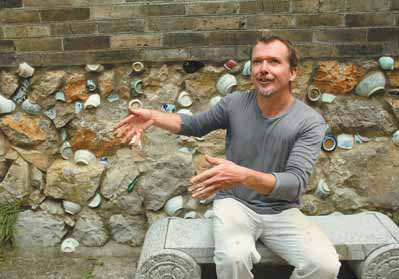Reconstructing renovation
Updated: 2013-09-17 07:26
By Li Yang (China Daily)
|
||||||||
A South African architect rebuilds notions about refurbishing traditional structures in a rural Chinese village. Li Yang reports.
Villagers call him "Crazy Ian". The nickname was invented years ago, when he started renovating tumbledown buildings in Jiuxian village, a rural settlement flanking the Guangxi Zhuang autonomous region's Yangshuo area.
But South African architect Ian Hamlinton's apparent madness is now accepted as genius, since he effectively constructed a new approach to rebuilding, rather than replacing, crumbling structures.
The 40-year-old has inspired local farmers to rethink the demolish-and-replace model that rules China's development by renovating dilapidated edifices into modern and functional structures.
Hamlinton and his ideas have gradually found a home in the village - where he has lived for four years and plans to stay indefinitely - starting with his 2009 renovation of a 200-year-old mountainside dwelling. The house was overgrown with grass and trees, and its roof had collapsed.
The architect spent two years renovating the house into a beautiful two-story building with a first-floor gallery. He planted a tree in the hallway as a memento to the structure's previous state. And he used the original bricks and tiles wherever he could.
Hamlinton worked alone on the project. That was when locals started calling him "Crazy Ian" - a moniker that has persisted after villagers realized upon seeing his project's results that his motivation comes more from cleverness than madness.
Hamlinton is well traveled. He worked in Egypt, Jordan, India, Nepal and Thailand before moving to China.
He fell in love with Yangshuo the moment he arrived. So, he sold his car and houses in South Africa to settle down in the area of southern China celebrated for its idyllic karst scenery.
But he was less impressed by some of the country's new architecture, which he considers "ugly" and "impractical" - especially when contrasted against its older buildings.
"It is cool in summer and warm in winter to live in the old buildings. It is the opposite in the new ones," he says.
"In China, people compare their own building with each other's, and all the buildings look the same. And they spend a lot of money to decorate the insides of the rooms with industrial products.
"I like things very simple, and I don't add things to make beauty. The mud walls and the wood are natural things that make people comfortable."
Hamlinton innovated with what he could scrounge up during the renovation. On the grounds surrounding the house, he discovered dozens of porcelain shards - some dating to the Qing Dynasty (1644-1911) and some from the 1960s and 1970s that are engraved with Mao Zedong quotes. He embedded them in the house's exterior walls.
The house is the first house he rented from the villagers. He uses the first floor as a gallery. He used to live on the second floor. Now he has transformed it into a storeroom. He lives in another house rented from the villagers.
Hamlinton visited the town and county governments to ask permission before starting his project.
He was surprised at how easily they approved his proposal. But that wasn't the end of his dealings with the authorities.
Officials found problems with the building during inspections. Villagers also took issue with his work, says Zhang Weifei, Hamlinton's business partner in the hotel they later opened in the village. Zhang says Hamlinton "drank his way through" these disagreements, lubricating the social friction with boozy banter.
Upon completing his first renovation, Hamlinton started reincarnating four other dilapidated buildings in Jiuxian. These became the Secret Garden hotel he and Zhang run.
His work has made him something of a local celebrity - especially among the opposite sex.
"He's famous around here," Zhang says.
"And there's no shortage of women chasing him. We didn't understand at first why a hardworking man like him decided to remain single. Gradually, we came to see he enjoys his life working on buildings, gardens and mountains."
Hamlinton says he wants a "free life".
"All of my Chinese pals are married, and they complain to me about their lives when they are drunk," he says.
Secret Garden now employs 11 villagers. Zhang runs the business, while Hamlinton is in charge of the buildings.
Hamlinton built sewer lines for them that run to rice paddies at the foot of a mountain. They pass through gravel paths, aquatic flowers and grass that cleanse the wastewater before it reaches farmlands.

While he follows feng shui indoors, the garden is very natural - a departure from traditional Chinese gardens' formality. "I like using my own hands to make things - but not money," he says.
While locals consider Hamlinton eccentric, they've accepted him as one of their own.
Kang Niansheng, a driver for the hotel, says: "He's a little different from other foreigners. He's crazy. Few foreigners treat Yangshuo as home. But he does. He drinks, argues and works with us. He's no different from other villagers."
Tang Xiaozhen, a waitress in her 20s, says: "Crazy Ian has never stopped adapting to Chinese culture with an open mind, just like he has never stopped rebuilding old houses. He always wears a smile."
Hamlinton says he doesn't see what all the fuss is about.
"What I did is quite normal in my country," he says.
"I don't understand why the media come to me every week and ask me again and again what my dream is."
Long Yanxiu contributed to the story.
Contact the writer at liyang@chinadaily.com.cn.
|
Ian Hamlinton explains how he found porcelain bowl pieces and used them to mend the old wall in his hotel Secret Garden in Yangshuo county, the Guangxi Zhuang autonomous region. Huo Yan / China Daily |
(China Daily 09/17/2013 page18)

 Victoria Beckham S/S 2014 presented during NYFW
Victoria Beckham S/S 2014 presented during NYFW
 'Despicable' minions upset Depp's 'Lone Ranger' at box office
'Despicable' minions upset Depp's 'Lone Ranger' at box office
 'Taken 2' grabs movie box office crown
'Taken 2' grabs movie box office crown
 Rihanna's 'Diamonds' tops UK pop chart
Rihanna's 'Diamonds' tops UK pop chart
 Fans get look at vintage Rolling Stones
Fans get look at vintage Rolling Stones
 Celebrities attend Power of Women event
Celebrities attend Power of Women event
 Ang Lee breaks 'every rule' to make unlikely new Life of Pi film
Ang Lee breaks 'every rule' to make unlikely new Life of Pi film
 Rihanna almost thrown out of nightclub
Rihanna almost thrown out of nightclub
Most Viewed
Editor's Picks

|

|

|

|

|

|
Today's Top News
Going green can make good money sense
Senate leader 'confident' fiscal crisis can be averted
China's Sept CPI rose 3.1%
No new findings over Arafat's death: official
Detained US citizen dies in Egypt
Investment week kicks off in Dallas
Chinese firm joins UK airport enterprise
Trending news across China
US Weekly

|

|








